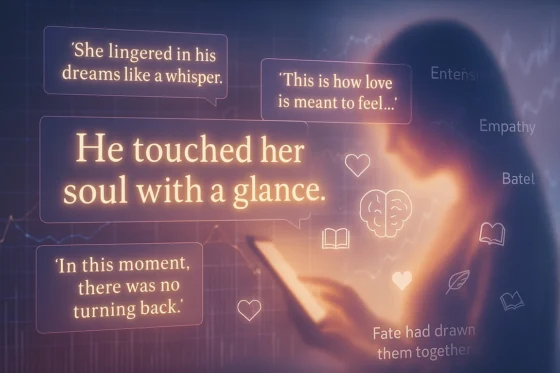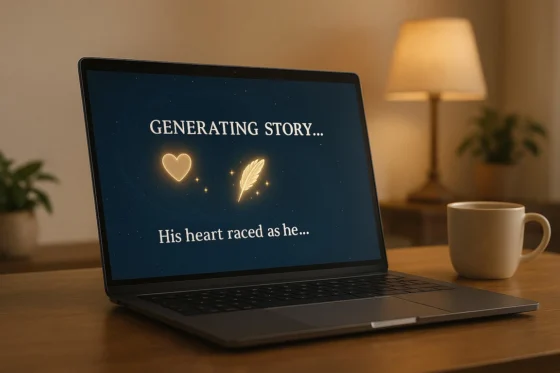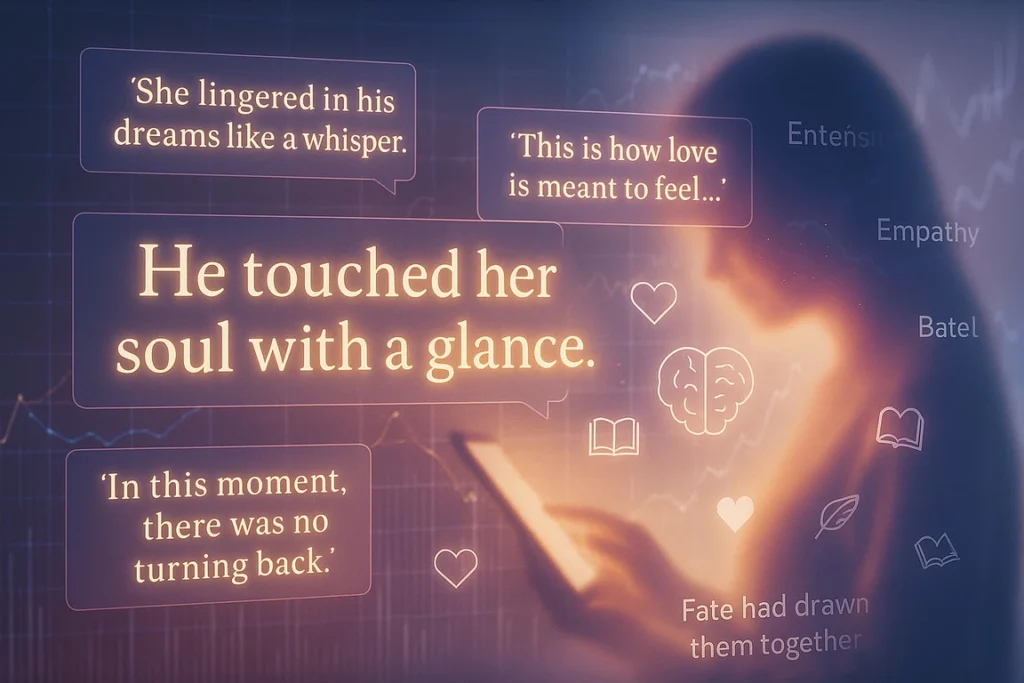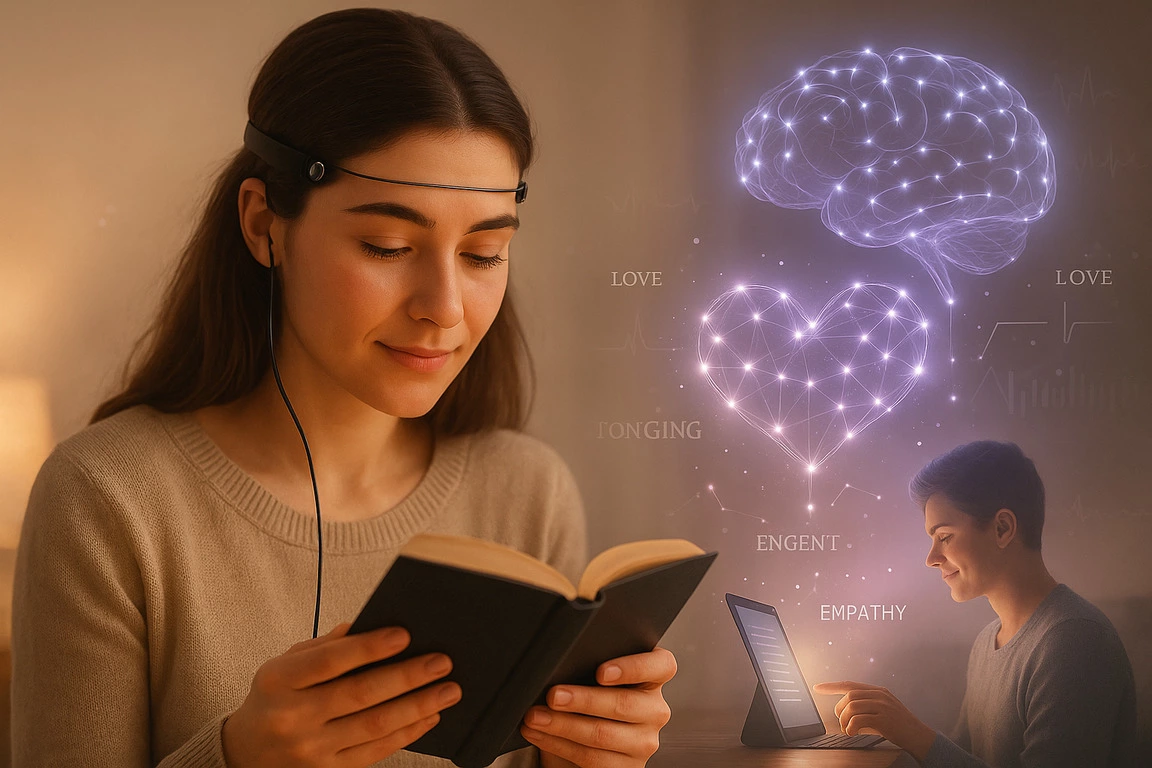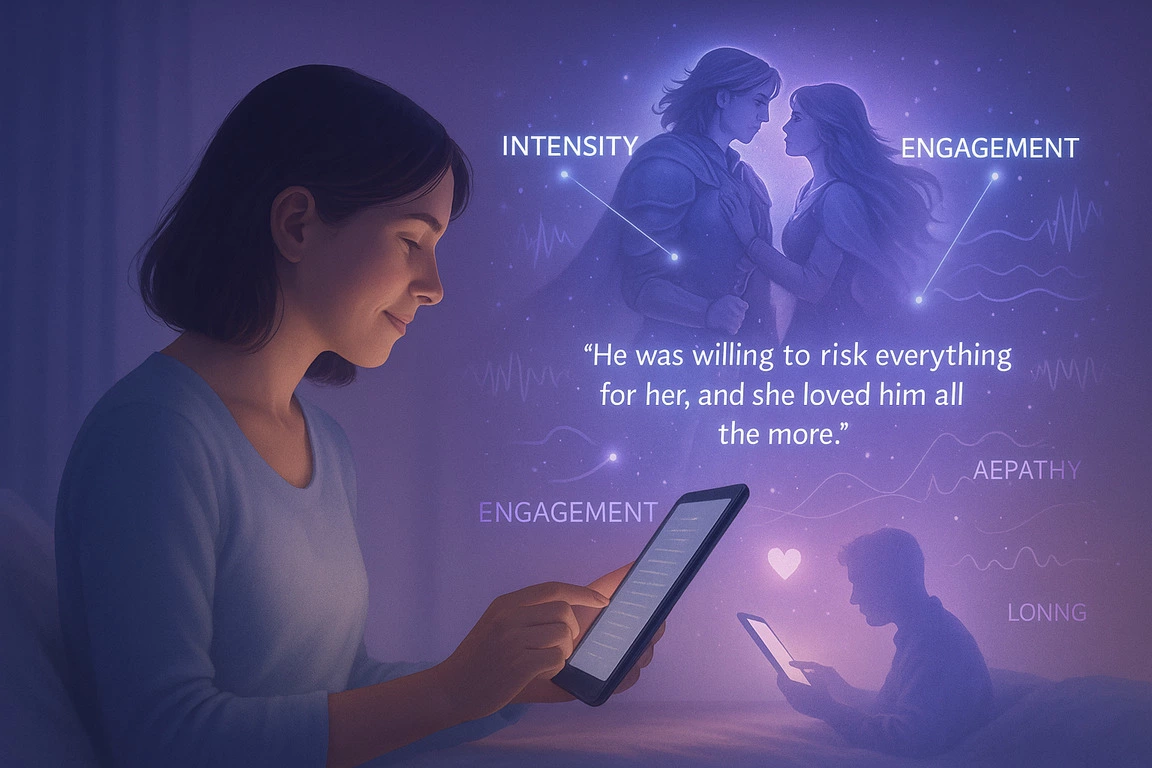AI romantasy—the fusion of AI-driven storytelling and romantic fantasy—has emerged as one of the most emotionally engaging experiences for readers. As AI storytelling platforms (such as TalkToStory) evolve, a new set of data shows that readers are not just interested in these interactive narratives – they are personally connecting with them.
A survey done in 2025 by Talker Research and ThriftBooks showed that 21% of romance readers picture a famous person as their crush, 17% think about their spouse and 7% imagine their ex. These findings shed light on how modern readers are blurring the lines between fantasy, memory, and desire—especially within interactive formats like romantasy AI.
Unlike traditional romance novels, AI romance stories adapt in real time, responding to user choices and emotional tone. Because of this structure, readers can create characters that seem like real people and explore personal stories according to their interests.
In this article, we’ll explore what the studies reveal about emotional projection in AI romance, why it’s particularly powerful in AI romantasy settings, and how it’s transforming the way we connect with fictional love interests.
The Psychology of Emotional Projection in AI Romance
At the core of every compelling love story lies a fundamental truth: we don’t just read romance—we feel it. We often give it a personal touch. This practice of readers giving their own emotions and thoughts to fictional people has existed for a long time. But in the context of AI romance and interactive storytelling, it becomes something far more immersive and psychologically complex. This research finds that readers usually connect emotions in the story to their own lives.
Based on Green & Brock’s Transportation Theory (2002), deep involvement in a fictional world can cause a reader to feel and believe things as if they were real. It is in the romance genre that the emotional journey becomes most powerful through conflict, vulnerability and relatable human moments.
This theory is given fresh relevance through the findings of the 2025 Talker Research study. With 1 in 5 readers envisioning a celebrity crush and nearly as many picturing their spouse or ex-partner, we see clear evidence that romance stories—particularly those enhanced by romantasy AI platforms—serve as emotional mirrors. Readers become part of the love stories they read.
It is possible for the mind to create such experiences without using images. It has an impact on how readers react to the narrative, the dialogue and the final outcomes of the characters. And when the story is powered by AI romantasy tools that respond dynamically, that emotional investment is heightened even further.
Overall, the projection changes stories into things readers can touch and feel, making each one different from the next. And that’s exactly what makes AI romance and AI romantasy such a compelling evolution of the genre.
Love immersive experiences?
Join a growing TalkToStory Community and bring your characters, worlds, and stories to life alongside like-minded creators.
What the Talker Study Tells Us—and How It Relates to Romantasy AI
The 2025 Talker Research and ThriftBooks study provides one of the most detailed looks into how modern readers emotionally engage with romance fiction—and its findings are especially relevant to the rise of AI romantasy platforms.
A survey of 2,000 romance readers showed:
- About 21% think of a famous person as their ideal romantic interest.
- 17% view their spouse in their dream.
- About 7% find themselves thinking about their ex.
Such numbers highlight an important idea: people connect their own emotions to the stories they read. It’s not only about getting away from reality; it’s also about discovering who we are. And when the romance story adapts in real time, as it does in romantasy AI, the connection becomes even deeper.
Another surprise discovery? Men identify as bigger romance fans than women do (63% vs. 60%) and they also read more hours in a year (364 hours compared to 312 for women). This challenges outdated assumptions about who consumes romance—and highlights a growing, diverse audience for AI romance experiences.
What does this mean for storytelling platforms like TalkToStory?
It suggests that:
- Interactive AI romance allows readers to feel real emotions since they are involved.
- The use of personalization—including tone, speed and character features—is crucial for meeting those expectations.
- Playing through a romance story multiple times, changing your choices, feels like reflecting on real-life relationships.
Ultimately, these insights underscore why AI romantasy resonates so strongly. People don’t just like fantasy romance; they want to make the story their own by relating it to their own feelings and memories. With romantasy AI, they can do precisely what they aim for.
Love immersive experiences?
Join a growing TalkToStory Community and bring your characters, worlds, and stories to life alongside like-minded creators.
Why AI Romantasy Amplifies Emotional Projection
In traditional stories, readers project emotions, but the tale doesn’t change. In contrast, AI romantasy transforms this process into a two-way interaction. Not only does the reader participate in the story, but the story also changes as a result. This interactivity lies at the heart of what makes romantasy AI so emotionally immersive.
The use of choice-based stories, memory features and adaptive conversations of AI romantasy apps allow readers to make characters and feelings all their own. A romantic interest in an AI romance platform doesn’t just follow a script—they respond to tone, recall past conversations, and evolve as the relationship unfolds.
Key Mechanics That Drive Emotional Depth in Romantasy AI
Emotional mirroring
Based on how you interact with an AI romance story, characters will change their behavior and responses. Select vulnerability and it can make the character more caring or guarded. Avoid dealing with the situation and they might start to distance themselves or fight with you. By doing this, the relationship in AI romantasy seems genuine and like what people really go through.
Narrative memory
Romantasy AI platforms are now equipped with memory prompts that help them remember things players have decided as their story progresses. If a character breaks trust right away, that issue could come up again in a later scene with tension or resolution. The connection between books makes readers more emotionally involved.
Character personalization
You can make choices about the love interest’s looks, tone of voice, behavior and romantic role (grumpy prince, gentle healer, immortal defender, for example). When a character becomes emotional or recalls memories, it allows us to feel like the character belongs to us.
As stated in a 2023 report in the Games and Culture Journal, games with emotionally active characters show a 58% rise in people’s engagement and memory compared to games that only follow a single narrative path. According to a 2022 study by Lemke et al. on narrative-based AI interfaces, having customizable romantic characters boosts emotional involvement by more than 60%, mainly when combined with features that keep track of memories and tone.
In AI romantasy, this effect is magnified by the genre’s intrinsic emotional tension: forbidden love, magical destinies, and slow-burning trust are all intensified when readers are choosing the pacing and outcome. A romantic fantasy is no longer something to observe—it becomes something to live.
Choice Creates Ownership
In AI romance, the ability to choose dialogue, make relationship decisions, and steer conflict resolution doesn’t just empower readers—it invites deeper emotional involvement. For example:
- Timing your confession of feelings can turn a scene into a touching moment, a passionate scene or an awkward situation.
- Choosing what to do about betrayal (forgive, get even, pull away) is similar to how we react in the real world.
- There are several different routes that allow players to see the same relationship unfold in many ways.
Such an interaction makes it possible for readers to build the AI romance story themselves. And in the case of AI romantasy, that construction happens in lush fantasy worlds where high-stakes emotion (forbidden love, magical binding, time-crossed soulmates) aligns perfectly with high-impact personalization.
Love immersive experiences?
Join a growing TalkToStory Community and bring your characters, worlds, and stories to life alongside like-minded creators.
Why AI Romantasy Works – Retention, Replay & Emotional Engagement
The immersive qualities of AI romantasy are quite measurable. When emotional projection, personalization and interactivity meet, users are drawn in and may start using the romantasy AI storytelling platform more often. People do not just enjoy reading, but they feel involved in what happens.
AI Romance Drives Deeper Reader Retention
According to research from Games and Culture Journal (2023), people who experienced emotionally responsive, branching stories were more likely to finish and replay them than those who read fixed plots. This is especially relevant in AI romance, where:
- Memory-based interactions build trust and payoff over time.
- AI-driven characters respond emotionally to reader input, increasing perceived authenticity.
- Narrative outcomes reflect personal decisions, making the ending feel earned.
On romantasy AI platforms like TalkToStory, this dynamic is heightened by the genre’s natural intensity: magical fates, secret love pacts, and power-laced betrayals keep the stakes high and the emotions raw.
Replaying the Same Romance—For Different Reasons
According to the 2025 Talker Research, 85% of people are likely to finish a gripping romance book in one night and many reread it several times to revisit their favorite moments. In AI romantasy, that impulse becomes part of the experience.
Replay is not only about repeating what you did; it’s about feeling something different each time.
- One version may explore forgiveness and healing.
- Another may explore self-worth through rejection or boundaries.
- A third may indulge in escapist wish-fulfillment (e.g., choosing the fated prince).
Every path offers a new emotional result, reflecting the different kinds of love and heartbreak readers may have dealt with (or want to understand). Because emotions can change from session to session, players tend to keep coming back for more.
Emotional Stickiness of Romantasy AI Tales Fuels Long-Term Engagement
Whether through unresolved emotional threads, evolving characters, or multiple romance options, AI romance platforms are designed to sustain emotional curiosity.
“I have played the same romantasy AI story several times. I was making different decisions and each time it brought a new heartbreak—yet I couldn’t stop. Everything seemed so real to me.” — Review from TalkToStory
The mechanics that make these experiences sticky—emotional feedback loops, unpredictable plots and reinforcement of personal thoughts—were designed this way. They’re evidence that aI romantasy is doing more than telling stories. It creates the illusion of a relationship, focusing entirely on how the reader feels.
Final Thoughts on Romatasy AI – Love, Memory, and Mirror Worlds
The appeal of AI romantasy isn’t rooted in novelty—it’s rooted in emotional truth. Nowadays, readers are taking part in the stories they read by adding their own experiences, dreams and emotions. The rise of romantasy AI is proof that fiction is no longer a fixed experience—it’s an evolving mirror, shaped by our input and our imagination.
What the latest research makes clear—from the Talker Research survey to interactive narrative studies—is that AI romance works not because it mimics love, but because it allows readers to engage with love on their own terms. When readers see their own traits in characters, think through various story paths and feel strong emotions amid a fantasy world, they discover a personal side of stories they never imagined from code.
Having that much power requires us to act responsibly. Developers and storytellers in the AI romantasy space must build with emotional intelligence, offering readers not just freedom of choice, but freedom from harm. They go beyond entertainment by giving people a safe and encouraging place to express their emotions and share their stories.
The mix of fantasy and memory does not mean the machines are taking over romance. It’s making readers reconnect with it in ways that feel special and impactful to them.
Love immersive experiences?
Join a growing TalkToStory Community and bring your characters, worlds, and stories to life alongside like-minded creators.
Related Articles
